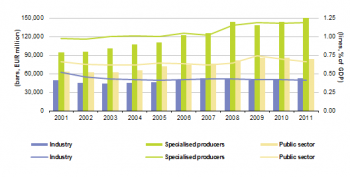- Data from Month Year, most recent data: Further Eurostat information, Main tables and Database.
Online interactions of European businesses and citizens with public administrations This article highlights the development and use of information and Communication technologies (ICT) for interacting with public administrations. This is one aspect of e-government, which is designed to improve public services and democratic processes by means of the Internet. Inclusion and better public services are part of the third priority of the i2010 initiative of the European Commission.
Main statistical findings
Obtaining information is the most frequent type of electronic interaction with public administrations, followed by the downloading of forms and the returning of completed forms. There is a steady increase in the proportion of individuals and businesses interacting with public authorities via the Internet in the European Union. The proportion of enterprises interacting with public bodies over the Internet is higher and growing faster than the proportion of individuals from 2004 to 2007. Finland is the EU Member State with the highest proportion of companies returning completed forms over the Internet and the Netherlands progressed most between 2004 and 2007 for returning completed forms. Considering the size, a higher percentage of large companies interact online with public authorities. More than one third of Internet users have already profited from e-government services and another 37% would be interested in doing so. Educational levels influence the degree of usage and interest in e-government services. The lack of personal contact is the reason most often given for abstaining from using e-government services. There is a correlation between the types of e-government services requested and a citizen's profile based on age, professional and social status
Text with Footnote [1]
Large enterprises are more likely to interact online with public authorities
The most frequent type of interaction with public administrations over the Internet is obtaining information, followed by downloading official forms. Returning completed forms is the less frequent type of interaction. In 2006, figures for downloading official forms by enterprises reached the same level as for obtaining information. The percentage of interaction of enterprises compared to individuals is much higher. In 2007, 58% of European enterprises compared to 18% of individuals downloaded official forms. The discrepancy is even higher for returning completed forms. The difference in the percentage of interaction between businesses and individuals can be partly explained by the disparity in Internet access and connection. 93% of businesses have Internet connections, compared to only 54% of households in 2007. In addition, businesses are likely to have more interactions with public authorities. These interactions offer a high potential for automating business processes. However, the actual level of interactions with public administrations is also determined by the latter's on-line availability. Finally, the reference period for enterprises was one year and three months for individuals. The highest increase in 2005 for both enterprises and individuals was for downloading forms, whereas in 2006, the interaction "returning completed forms" showed the highest growth rates. This type of interaction is very interesting for economising as it has the potential to be fully automated. From the public administration side, receiving completed forms represents a first step towards full electronic case handling. In 2007, all three types of interactions increase considerably for individuals, whereas the growth rate for enterprises lacks behind.
Subdivision 2
Data sources and availability
<description of data sources, survey and availability (completeness, recency) limitations>
Context
Publications
Further Eurostat information
- Title(s) of second level folder (if any)
- Title(s) of third level folder (if any)
- Title(s) of second level folder (if any)
- Title(s) of third level folder (if any)
<regulations and other legal texts, communications from the commission, administrative notes, policy documents, …>
For other documents such as Commission Proposals or Reports, see EUR-Lex search by natural number
External links
See also
Notes
- ↑ Text of the footnote.
[[Category:<category name(s)>]] [[Category:<statistical article>]]

